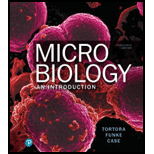
Concept explainers
Which could cause the disease it is supposed to prevent?
- a. attenuated measles virus
- b. dead Rickettsia prowazekii
- c. Vibrio cholerae toxoid
- d. hepatitis B antigen produced in yeast cells
- e. purified polysaccharides from Streptococcus pyogenes
- f. Haemophilus influenzae polysaccharide bound to diphtheria toxoid
- g. a plasmid containing genes for influenza A protein
Introduction:
Vaccine is used to prevent the disease. Vaccine are classified into following types: live attenuated vaccine, inactivated vaccine, toxoids, subunit vaccine, and conjugated vaccine. It can also be produced by the recombinant technology.
Explanation of Solution
- a. Live attenuated vaccine: The antigenicity of the pathogen is minimized and the live microbes are injected into humans. Antibodies are produced by the host against microbes. These antibodies prevent the infection caused by that specific virus in the host. For example, live attenuated measles virus. However, the attenuated strain of microbe in this type of vaccine may regain pathogenicity through mutations. In such cases, it may cause the disease for which this vaccine is used to prevent.
- b. Inactivated vaccine: In this type of vaccine, killed pathogen is into the patient and it is less effective. However, using this type of pathogen in live attenuated form, it may cause serious problems. It often needs a booster dose. For example, dead Rickettsia prowazekii.
- c. Subunit inactivated toxoid vaccine: Inactivated toxin are used to prevent disease that are known to be caused by toxins. In this type, the cells of microbes are not introduced into the human body. They need a booster dose after some period of time. For example, Vibrio cholera toxoid.
- d. Subunit vaccine: Antigenic portions of an antigen are injected into the patients, which cannot undergo replication. It is also termed as recombinant vaccine and it undergo better stimulation of the immune response. For example, Hepatitis B antigen produced in yeast cells and purified polysaccharides from Streptococcus pyogenes.
- e. Conjugated vaccine: Proteins combined with polysaccharides to fight against antigens of pathogenic microbes. It is used in children to give a strong immune response. For example, Haemophilus influenzae polysaccharides bound to diphtheria toxoid.
- f. DNA Vaccine: It is otherwise known as nucleic acid vaccine. It is still carried out in the experimental phase and not in practice. Here, the recombinant plasmid is isolated and injected into humans. This undergo gene expression and synthesize antigens that are specific in preventing the disease. For example, a plasmid containing influenza A protein.
Disease is prevented by gaining the antibodies by administering the attenuated live microbe, dead pathogens, or toxoids. Such vaccines could prevent the infection that occurs for the next time.
Want to see more full solutions like this?
Chapter 18 Solutions
Microbiology: An Introduction Plus Mastering Microbiology with Pearson eText -- Access Card Package (13th Edition) (What's New in Microbiology)
Additional Science Textbook Solutions
Biological Science (6th Edition)
Applications and Investigations in Earth Science (9th Edition)
Genetics: From Genes to Genomes
Campbell Essential Biology (7th Edition)
- 9 S es Read the section "Investigating Life: In (Extremely) Cold Blood." Then, drag and drop the terms on the left to complete the concept map. Red blood cells Genes Icefishes -have mutated have colorless Oxygen have few lack encode Blood Cellular respiration consists of- contain carries is a Platelets White blood cells carries low amounts of Hemoglobin is necessary for Plasma Protein Reset.arrow_forwardPlating 50 microliters of a sample diluted by a factor of 10-6 produced 91 colonies. What was the originalcell density (CFU/ml) in the sample?arrow_forwardEvery tutor here has got this wrong, don't copy off them.arrow_forward
- Suppose that the population from question #1 (data is in table below) is experiencing inbreeding depression (F=.25) (and no longer experiencing natural selection). Calculate the new expected genotype frequencies (f) in this population after one round of inbreeding. Please round to 3 decimal places. Genotype Adh Adh Number of Flies 595 Adh Adh 310 Adhs Adhs 95 Total 1000 fladh Adh- flAdn Adh fAdhs Adharrow_forwardWhich of the following best describes why it is difficult to develop antiviral drugs? Explain why. A. antiviral drugs are very difficult to develop andhave no side effects B. viruses are difficult to target because they usethe host cell’s enzymes and ribosomes tometabolize and replicate C. viruses are too small to be targeted by drugs D. viral infections usually clear up on their ownwith no problemsarrow_forwardThis question has 3 parts (A, B, & C), and is under the subject of Nutrition. Thank you!arrow_forward
- They got this question wrong the 2 previous times I uploaded it here, please make sure it's correvct this time.arrow_forwardThis question has multiple parts (A, B & C), and under the subject of Nutrition. Thank you!arrow_forwardCalculate the CFU/ml of a urine sample if 138 E. coli colonies were counted on a Nutrient Agar Plate when0.5 mls were plated on the NA plate from a 10-9 dilution tube. You must highlight and express your answerin scientific notatioarrow_forward
 Concepts of BiologyBiologyISBN:9781938168116Author:Samantha Fowler, Rebecca Roush, James WisePublisher:OpenStax College
Concepts of BiologyBiologyISBN:9781938168116Author:Samantha Fowler, Rebecca Roush, James WisePublisher:OpenStax College Medical Terminology for Health Professions, Spira...Health & NutritionISBN:9781305634350Author:Ann Ehrlich, Carol L. Schroeder, Laura Ehrlich, Katrina A. SchroederPublisher:Cengage Learning
Medical Terminology for Health Professions, Spira...Health & NutritionISBN:9781305634350Author:Ann Ehrlich, Carol L. Schroeder, Laura Ehrlich, Katrina A. SchroederPublisher:Cengage Learning Biology (MindTap Course List)BiologyISBN:9781337392938Author:Eldra Solomon, Charles Martin, Diana W. Martin, Linda R. BergPublisher:Cengage Learning
Biology (MindTap Course List)BiologyISBN:9781337392938Author:Eldra Solomon, Charles Martin, Diana W. Martin, Linda R. BergPublisher:Cengage Learning Biology: The Unity and Diversity of Life (MindTap...BiologyISBN:9781305073951Author:Cecie Starr, Ralph Taggart, Christine Evers, Lisa StarrPublisher:Cengage Learning
Biology: The Unity and Diversity of Life (MindTap...BiologyISBN:9781305073951Author:Cecie Starr, Ralph Taggart, Christine Evers, Lisa StarrPublisher:Cengage Learning





